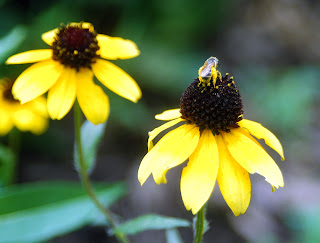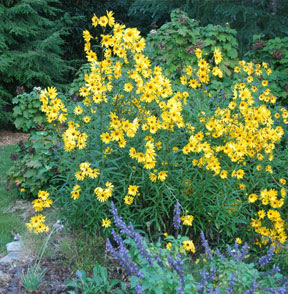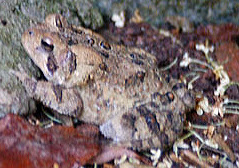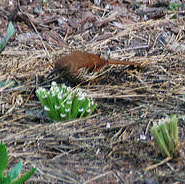We've been wanting a decent path to the front door for a long time. We bought our house from the second owner; he seemed to use  the side door into the master bedroom primarily. Odd, but effective. The path to the front door was grass, with a few half-buried concrete stepping stones evident, and the whole surface quite uneven because of roots and chipmunk tunnels. After we finally had lights installed in the garage, and the front porch lights repaired, it seemed like a good idea to finally put in a front path.
the side door into the master bedroom primarily. Odd, but effective. The path to the front door was grass, with a few half-buried concrete stepping stones evident, and the whole surface quite uneven because of roots and chipmunk tunnels. After we finally had lights installed in the garage, and the front porch lights repaired, it seemed like a good idea to finally put in a front path.
It's been on my project list for awhile, along with a small wildlife pond. Last summer, with a bit more free time, I'd had a couple of landscapers come over to give me estimates. The first, working with a very reputable company, took a long time to provide an estimate, one that had my helpful gardening assistant (not Mocha, our Golden Retriever) gasping, and saying that he could easily dig the path base for me. The second estimate was a bald dollars per square foot estimate, and could he use his Bobcat to scrap down the area (no, because of the roots of the big water oak and pine).
I asked a younger colleague to give me an estimate as well. This was in the hottest part of August when the soil was incredibly hard. He and a couple of friends do work on the weekends, but clearly they weren't enthusiastic about excavating our hard Piedmont clay in the summer by hand.
So, after things had cooled down in the fall, and we'd had a bit of rain, at least enough to moisten the top inch of soil, I said that I'd get a couple of pallets of stone that Saturday morning. My gardening companion, more focused on the home game that he was heading off to, said 'great' and went off to work on writing his book and then on to the game.
 I went and selected a couple of pallets of stone, taken aback a bit at the size of the flagstones. The pallets I'd got in the past were nice small stones, which I was quite proud of myself for stacking up in attractive low walls. But I was heartened by the fellows at the stone shop -- they didn't laugh at me about how I couldn't move these stones, but said that I wouldn't need to go to the gym to lift weights after moving the stones (they're between 15 and 45 lbs.
I went and selected a couple of pallets of stone, taken aback a bit at the size of the flagstones. The pallets I'd got in the past were nice small stones, which I was quite proud of myself for stacking up in attractive low walls. But I was heartened by the fellows at the stone shop -- they didn't laugh at me about how I couldn't move these stones, but said that I wouldn't need to go to the gym to lift weights after moving the stones (they're between 15 and 45 lbs.
My gardening companion, returning home after the game, took a look at me ineffectually trying to dig up the turf, and grumped about how he was planning to move mulch that afternoon, but then went to work. He's much more able than me (I didn't get the hefty shoulder and arm genes) to scrap up the turf and get it ready for the paver base, made up of the granite dust that packs so nicely.

Now, I'm figuring that our clayey soils don't need the recommended 6" of paver base (hello, what about the roots of our trees?) and these stones don't look like they're going anywhere, so I'm trying to settle them in as best I can, in an attractive pattern, and sift the granite dust around them.
After last weekend, I felt like I'd been beaten with sticks, but had recovered enough by this weekend to lay another good bit of stone, after my gardening companion dug out the base.
 So, if I can do this, with decent fitness, and weight-training with wimpy weights twice a week, I figure that it's certainly within reach of fit gardeners, especially if they are stronger than I am.
So, if I can do this, with decent fitness, and weight-training with wimpy weights twice a week, I figure that it's certainly within reach of fit gardeners, especially if they are stronger than I am.
For the rest of the path story, see Laying a flagstone path (2).
There's lots of help online - just google creating a stone path, or building a stone path, but my favorite reference is a book by Barbara Pleasant, Garden Stone.
The complete photo sequence of creating this path is posted in a Picasa Web gallery.
Read more...
 I've been reading about gardening in a time of climate change recently, not a particularly uplifting topic. So I've been thinking about what it will mean for our native plants, the plants we can grow in our gardens, wherever we are, and how weather unpredictability will affect the plants (native or not) that we love.
I've been reading about gardening in a time of climate change recently, not a particularly uplifting topic. So I've been thinking about what it will mean for our native plants, the plants we can grow in our gardens, wherever we are, and how weather unpredictability will affect the plants (native or not) that we love. can 'green' themselves by planting a diversity of trees, shrubs, and perennials and encourage gardening for food and wildlife, and become living spaces in the process.
can 'green' themselves by planting a diversity of trees, shrubs, and perennials and encourage gardening for food and wildlife, and become living spaces in the process.










